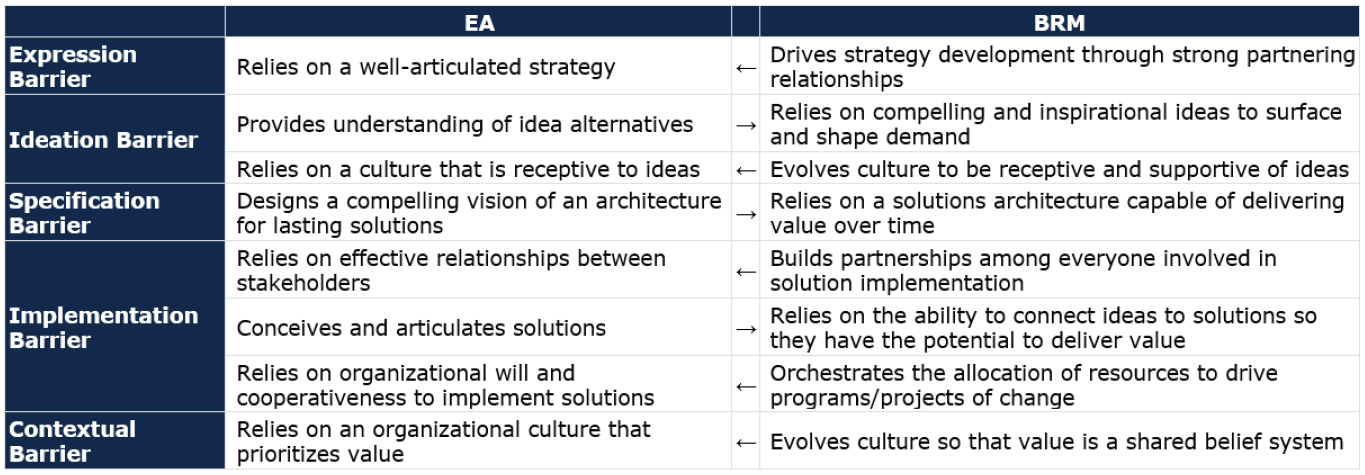Enterprise Architecture and BRM: Allies in Strategic Purpose
Nothing creates a special bond more than having a common purpose and a mutual reliance. Effective Enterprise Architects and Business Relationship Managers have such a bond.
TOGAF® states:
“The purpose of Enterprise Architecture is to optimize across the enterprise the often fragmented legacy of processes (both manual and automated) into an integrated environment that is responsive to change and supportive of the delivery of the business strategy.”
In the end, the purpose of Enterprise Architecture (EA) is to reduce the cost of strategic change.
Or, put more positively: to optimize the value of strategic investments by means of a resilient, integrated environment.
In contrast, the mantra of Business Relationship Management Institute is:
Drive Value, Build Partnerships, Evolve Culture; Satisfy Purpose.
In other words, the purpose of Business Relationship Management (BRM) is: to drive the optimization of value realized from investments by means of strong partnerships and a value-focused culture throughout the enterprise.
EA and BRM Share a Mutual Purpose

As seen in Figure 1, both EA and BRM share a commonality of purpose: to optimize strategic value. It is a great purpose; one that is meaningful to many people and one to take immense pride in.
However, the means to their common purpose is what is different, and in this difference, both EAs and BRMs need each other. Let’s explore their mutual reliance.
A Question of Domain

On the left, the Problem Domain represents both the challenges and opportunities an enterprise faces.
One needs a high degree of “Business Savvy” to understand the nuances and implications of the Problem Domain.
On the right, the Idea Domain represents the infinite alternatives of technology and organizational methods that could be applied to problems.
One needs a high degree of “Systems Savvy” to understand the nuances and implications of the Idea Domain.
The intersection in the middle is the Solutions Domain: the application of the potential inherent in the Idea Domain to address the opportunities inherent in the Problem Domain. Ultimately, the Solutions Domain is the source of value, both value achieved and value lost.
One needs both “Business Savvy” and “Systems Savvy” as a rite-of-passage into the Solution Domain, but that is not enough to be effective. One also needs a “Conceptual Savvy”.
The outer box is the Contextual Domain which represents the complete environment that encompasses and impacts the other domains. It includes anything that changes the perception of the other domains. At the core of the Contextual Domain is organizational culture – the shared belief system that drives behaviors, both rational and irrational.
How to Drive Value in the Contextual Domain
It takes unrelenting perseverance in evaluating alternatives while repetitively making incremental additions and subtractions from the alternatives.
It takes high intellectual integrity to be open to ideas from any direction.
And it takes some type of pixie dust we’ll never be able to bottle, but is of the same make of a child’s imagination.
Potential Barriers to Purpose
While EA and BRM share the common purpose of optimizing strategic value, each domain has barriers to achieving that purpose as shown in Figure 3.

The Expression Barrier prevents the overall interrelationships and priorities of all problems or opportunities from being understood. A poor organizational strategy, or none at all, is a common symptom of an Expression Barrier.
The Ideation Barrier prevents ideas from germinating or being considered.
The Specification Barrier prevents the nuances and implications of a problem or opportunity from being understood.
The Implementation Barrier prevents good ideas from being built.
The Contextual Barrier gets in the way of everything, including the way value is measured or perceived. 1
BRM and EA Complement Each Other
Overcoming these barriers requires both effective Enterprise Architecture and Business Relationship Management. Figure 4 below illustrates the synergy and mutual reliance of EA and BRM.

Synergize BRM and EA to Drive Strategic Value
At the heart of the synergy between EA and BRM is the EA’s gift at conceiving solutions and the BRM’s ability to breathe life into those solutions.
History has given many examples of great partnerships between those with great ideas and those who drive the ideas to fruition. It is difficult for one person to play both roles, especially in a complex environment in which the problems range from non-trivial at best all the way to dealing with things that have never before been solved.
For this reason, EA and BRM are complementary and supportive roles and disciplines, and not the same thing. They each are focused on different domains even while being adept at the others.
Enterprise Architects and Business Relationship Managers have a common purpose.
They have a mutual reliance.
They are allies in the pursuit of strategic value.
1 The Framework and Barriers were inspired by the book, Leveraging the New Infrastructure: How Market Leaders Capitalize on IT by Peter Weill and Marianne Broadbent.
